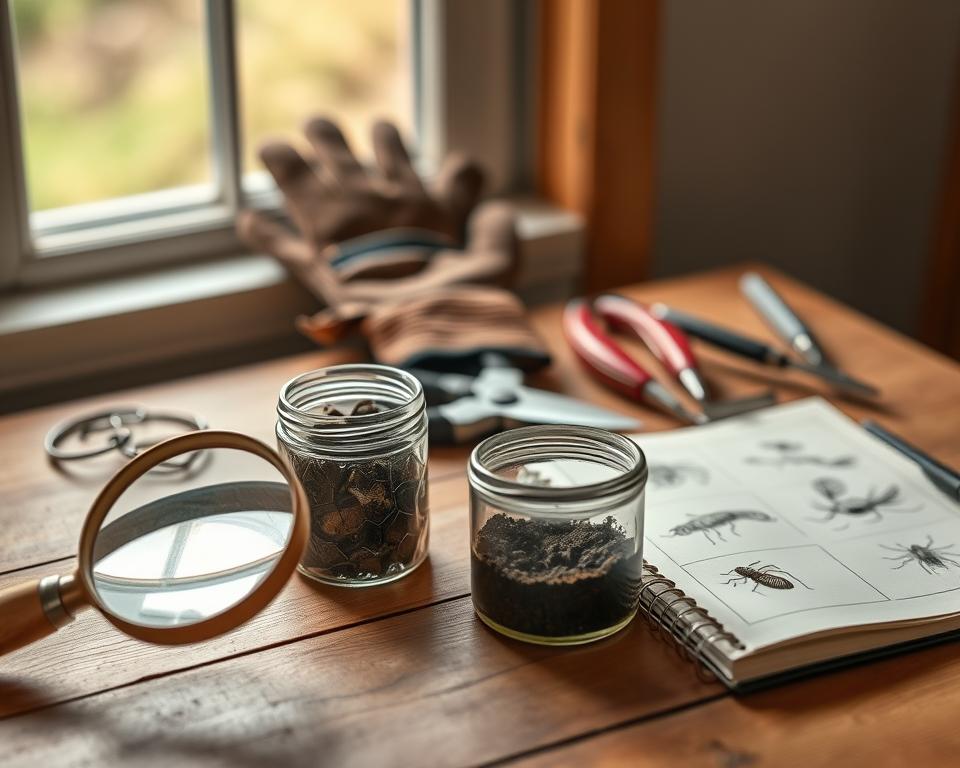Organic pest control and natural pest management are key to sustainable farming. They protect crops and preserve the environment. By employing beneficial insects, crop rotation, and natural pesticides, farmers cut down on harmful chemicals. This approach ensures healthier ecosystems and safer food.
Adopting organic practices boosts soil health and saves pollinators. It also prevents pesticide resistance. Techniques like companion planting and microbial pesticides offer long-term benefits without harming the environment. This guide delves into effective strategies for pest management, ensuring ecological balance.
Key Takeaways
- Organic farming reduces pesticide use by 97%, enhancing ecosystem health.
- Neem oil controls over 200 pests and fights fungal diseases like powdery mildew.
- Companion planting (marigolds with tomatoes, basil with peppers) cuts pest damage by up to 30%.
- Beneficial insects like ladybugs eat 50 aphids daily, reducing pest populations naturally.
- Integrated Pest Management lowers pest-related crop loss by 30% through holistic strategies.
Understanding Organic Pest Control
Organic pest control aims to maintain healthy ecosystems to naturally combat pests. It employs eco-friendly pest solutions such as crop rotation, beneficial insects, and natural repellents. This method prioritizes long-term soil health and biodiversity, allowing farmers to eradicate pests sustainably without synthetic chemicals.
“Organic pest management starts with healthy soil. Strong plant roots resist pests better than weakened plants,” states the Virginia Cooperative Extension.
- Monitoring pest populations regularly to spot early signs of infestation
- Using physical barriers like row covers to block insects
- Selecting pest-resistant plant varieties
- Applying approved botanical pesticides as a last resort
USDA regulations mandate that farmers document their practices in an Organic System Plan (OSP). This ensures their methods meet 7 CFR §205.206 standards. Unlike synthetic pesticides, organic methods target specific pests while preserving beneficial species. Organic products may need more frequent application, but they reduce harm to pollinators and soil microbiology over time. Farmers must balance patience with precision, applying treatments at the right pest life stage for maximum effectiveness.
Overview of Common Farm Pests
Identifying pests early and understanding their life cycles are critical steps in using non-toxic pest control methods and environmentally safe pest removal. Recognizing common pests and their behaviors is essential to protect crops effectively.
Identification of Common Pests
Many pests cause visible damage. Here’s how to spot key threats:
- Colorado Potato Beetle: Red-and-black striped larvae attack potato leaves, causing up to 50% yield loss if untreated.
- Bollworms: Caterpillars feed on cotton and corn, reducing yields by 10–30%. Look for chewed leaves and stems.
- Armyworms: These pests can strip entire fields overnight. Check for ragged leaf edges and sawdust-like frass (waste).
- Cabbage Caterpillars: White butterflies lay eggs under leaves; larvae eat foliage, causing 40% losses if unchecked.
Life Cycles of Key Farm Pests
Knowing when pests breed or pupate allows farmers to act at the most vulnerable stages. For example:
| Pest | Life Stages | Vulnerable Stage | Control Options |
|---|---|---|---|
| Colorado Potato Beetle | Egg → Larva → Pupa → Adult | Larval stage (before leaf destruction) | Handpicking or introducing predator beetles |
| Bollworm | Egg → Caterpillar → Moth | Egg clusters on undersides of leaves | Neem oil sprays or parasitic wasps |
| Armyworm | Egg → Caterpillar → Moth | Young caterpillars (before mass feeding) | Cultural practices like crop rotation |
Integrated Pest Management (IPM) involves four steps: Identify the Pest, Monitor Pest Activity, Choose Control Methods, and Evaluate Results.
By timing interventions to pest life stages, farmers can reduce reliance on harmful chemicals. For example, disrupting soil-dwelling pests like weevils with crop rotation aligns with environmentally safe pest removal principles. Early identification paired with biological controls like beneficial insects ensures crops thrive without synthetic pesticides.
Natural Solutions for Insect Pests
For farmers focusing on chemical-free pest prevention, nature provides robust alternatives. Beneficial insects can serve as your primary defense. Ladybugs, lacewings, and parasitic wasps prey on pests without damaging crops. Incorporate pollen-rich flowers to attract these beneficial allies.
Beneficial Insects
Support predators like praying mantises and ground beetles by eschewing broad-spectrum sprays. Parasitic wasps effectively manage caterpillars without harming plants. Ladybugs devour aphids, while lacewings target mealybugs and whiteflies.
Organic Insecticides
When pests become a problem, plant-based solutions are the answer:
- Neem oil: Mix 2 tsp neem oil with 1 tsp dish soap in 1 quart water to disrupt pest lifecycles.
- Pyrethrin sprays: Derived from chrysanthemums, effective against flying insects but avoid using around cats or aquatic areas.
- Diatomaceous earth: A natural abrasive powder lethal to ants and fleas when applied to dry areas.
Home Remedies
Create DIY sprays from kitchen staples:
- Garlic spray: Blend 2 garlic bulbs with water, strain, and dilute 1:4 for a repellent.
- Hot pepper spray: Mix 1 tbsp chili powder with 1 quart water to deter beetles.
- Tomato leaf spray: Steep 2 cups fresh tomato leaves overnight in water, strain, and apply to leaves.
Always test sprays on small plant sections first.
Strategies for Weed Management
Weeds compete with crops for nutrients and sunlight, but organic pest control provides effective alternatives. Farmers can manage weeds without chemicals through manual labor, mulching, and planting cover crops. These methods not only preserve soil health but also enhance crop yields.
“Cereal rye suppresses weeds better than any synthetic tool,” says David Stern, who uses cover crops on 30% of his farmland. His system cuts weed pressure by 40% without herbicides.
- Manual Removal: Hoes and cultivators are most effective when weeds are young. Early intervention prevents weeds from developing roots and spreading seeds.
- Organic Mulches: Straw or wood chips block light, killing weed seeds. A 3-inch layer of coarse mulch like wood chips can stop 90% of annual weeds. Buckwheat mulch, priced at $9 per bushel, adds nitrogen while suppressing crabgrass and purslane.
- Cover Crops: Cereal rye releases chemicals that inhibit weed growth. Crimson clover and oats planted in August grow 4′ tall before winter, forming a natural mulch. Roll-crimping these crops creates a soil blanket that lasts months, reducing herbicide needs.
Crop rotation breaks weed cycles. For perennial pests like bindweed, combine mechanical tillage with winter-killed oats. Time planting to outcompete weeds—plant winter squash early to shade out pigweed. Avoid synthetic herbicides by timing cover crop termination precisely, ensuring they die naturally or are rolled into mulch.
Disease Prevention in Organic Farming
Steps like crop rotation and disease-resistant seeds protect plants from infections. These methods form the basis of natural pest management and sustainable pest eradication. They promote ecological balance.
Proper crop rotation can reduce disease pressure by up to 70%, making it a cornerstone of organic disease control.
Crop Rotation Practices
Rotating crops yearly disrupts disease cycles. Here’s a guide:
| Crop Family | Rotation Interval |
|---|---|
| Tomatoes (Solanaceae) | 3 years minimum |
| Cabbage Family (Brassicae) | 2 years minimum |
| Beans/Legumes | 1-2 years between plantings |
Choosing Disease-Resistant Varieties
Seek seeds with disease resistance codes. Key tips:
- Select region-specific varieties tested for local pathogens
- Check seed catalogs for codes like “F2” ( Fusarium resistance) or “V” (Verticillium resistance)
- Rotate resistant varieties yearly to prevent pathogen adaptation
Complementary Practices
Integrate these strategies for enhanced protection:
- Sanitation: Remove diseased plants immediately to prevent spread
- Soil care: Use compost to boost beneficial microbes (increases soil microbial activity by 50%)
- Airflow: Space plants properly to reduce humidity-driven diseases
These methods reduce treatment reliance and boost plant defenses. In the Midwest, farmers cut potato blight by 40% with rotation and resistant varieties. Focus on long-term soil health for lasting disease control.
Monitoring and Assessment Techniques
Effective organic pest control begins with consistent monitoring. Farmers employ visual inspections and traps to track pest activity early. Weekly checks during the growing seasons help catch infestations before they cause damage. This approach aligns with eco-friendly pest solutions that focus on prevention over reaction.
Visual Inspections
Regular scouting of fields reveals pest hotspots. Key steps include:
- Check plants at random intervals, focusing on vulnerable growth stages
- Track pest presence using damage signs like leaf spots or chewed edges
- Record data in matrices noting dates, locations, and pest counts
Note:Colorado potato beetles tolerate up to 20-60% defoliation without yield loss, depending on plant growth stages.
Traps and Lures
Pest-specific traps provide actionable data. Options include:
- Pheromone traps: Disrupt mating cycles for moths and beetles
- Sticky traps: Capture flying insects like aphids
- Pitfall traps: Monitor ground-dwelling pests in field borders
Placement near field edges maximizes effectiveness. Trap counts help determine when pest populations cross economic thresholds, guiding timely interventions.
“Early detection prevents costly losses. Sampling frequency and accurate records are the backbone of successful IPM programs.”
Modern tools like digital apps track weather patterns and pest development stages. These systems predict outbreaks and guide eco-friendly pest solutions, reducing reliance on chemicals. Farmers combining visual checks, traps, and tech create adaptive strategies that protect crops sustainably.
Creating a Balanced Ecosystem
Establishing a robust farm ecosystem begins with non-toxic pest control methods that mirror nature’s equilibrium. Companion planting is key, pairing crops to ward off pests while enhancing plant vigor. For instance, tomatoes flourish with basil nearby, while marigolds fend off nematodes. These green pest control services diminish chemical reliance and fortify natural defenses.
- Basil + tomatoes: Repels mosquitoes and aphids
- Marigolds + root vegetables: Deter beetles with their scent
- Nasturtiums as trap plants: Lure aphids away from main crops
Attract pollinators and predators to maintain equilibrium. Native wildflowers and hedgerows serve as sanctuaries for ladybugs, lacewings, and mantises. Each ladybug consumes 5,000 aphids in its lifetime. Birdhouses encourage insect-eating birds, and small brush piles attract frogs and toads that devour slugs. Even a birdbath supports biodiversity.
Structural diversity is crucial. Alternating tall and short plants disrupts pest movement. Incorporating flowering borders supports predatory wasps and bees. Over 60% of garden pests decline when beneficial insect populations stabilize, reducing harmful chemical use. This holistic strategy transforms the farm into a self-sustaining entity where nature manages pest control.
Regulatory Standards for Organic Pest Control
Understanding USDA Organic Certification is crucial for farmers. It ensures they adhere to strict guidelines for chemical-free pest prevention. The USDA Organic Basics detail the rules for pest management. These include using crop rotation and biological controls before resorting to other methods. Following these rules protects the certification and builds consumer trust.
| Status | Description |
|---|---|
| Under NOSB Review | NOSB evaluates substance eligibility |
| In Process | NOP implements NOSB recommendations |
| On Hold | NOP delays action pending new data |
| Closed | No further action planned |
| Complete | Recommendation finalized |
Natural pest management practices must align with the National List of Allowed and Prohibited Substances. Inputs like boric acid and botanical extracts are allowed, but synthetic materials require listing. Farmers must document all pest control steps, including failed methods before using approved products. Noncompliance risks losing certification—farmers must report all substances used.
- Only substances on the National List are permitted
- 75% of ingredients in “Made with Organic” products must be organic
- Annual inspections verify adherence to NOP standards
Staying informed about the Petitioned Substances Index is essential. Visit the USDA website to review updated guidelines. This ensures alignment with natural pest management best practices.
Educating and Engaging Farmers
Adopting sustainable pest eradication methods requires knowledge and community. Farmers embracing eco-friendly pest solutions achieve success through education and peer support. Workshops, online tools, and networks equip them with the skills to protect crops without chemicals.
Workshops and Seminars
Hands-on learning speeds up the adoption of organic practices. USDA extension services and groups like the Green Thumb Collective organize field days and training sessions. The Barlow Family Farm in Oregon, for example, reduced pesticide use by 30% after attending workshops.
Topics covered include introducing beneficial insects, setting up traps, and timing crop rotation. These sessions are crucial for farmers looking to transition to organic methods.
Online Resources and Communities
Access tools that fit your schedule:
- USDA’s Organic Integrity Database verifies certified suppliers
- eXtension.org offers free guides on IPM and natural repellents
- YouTube channels like “Organic Ag Hub” share demo videos on companion planting
| Resource | Focus | Benefits |
|---|---|---|
| Farmer’s Bookshelf | Online courses | Certification-ready materials |
| Organic Farming Research Foundation | Case studies | Success stories from real farms |
“Peer networks cut learning curves. We share what works in our region.” – Maria Chen, Organic Growers Network
Joining communities like the National Sustainable Agriculture Coalition connects farmers to grants and regional forums. Webinars hosted by the Sustainable Agriculture Research & Education program address challenges like aphid control and soil health. These resources turn theory into action, helping growers build resilient farms that protect profits and ecosystems.
Future Trends in Organic Pest Control
Organic pest control is evolving rapidly, blending technology and science with sustainable practices. New innovations are changing how farmers manage pests while keeping their methods eco-friendly. These advancements include smart tools and groundbreaking research, aiming for better results with less environmental harm.
New Breakthroughs in Sustainable Practices
- Lab studies show plant-based biopesticides can be 90% effective against aphids and mites.
- Research into gene expression enhances crop defenses without genetic modification, reducing pest attraction.
- Soil microbes are now crucial in suppressing nematodes, leading to 30% yield increases in trials.
Technology Shaping Green Pest Control Services
Smart systems are revolutionizing field management:
- AI analyzes satellite data to forecast pest outbreaks weeks ahead.
- Drones reduce pesticide use by 15% through precise spraying, saving farmers money.
- IoT sensors monitor pest activity 24/7, cutting chemical applications by 40%.
Over 70% of consumers now prefer plant-based pest solutions, driving the need for innovation in green pest control services.
Despite challenges like high tech costs and knowledge gaps, partnerships between farms and universities are helping. Farmers using these tools can expect increased efficiency and adherence to organic standards.
Getting Started with Organic Pest Control
Transitioning to organic pest control requires a well-thought-out plan, tailored to your farm’s specific needs. By adopting environmentally safe pest removal practices, farmers can significantly reduce their reliance on synthetic pesticides. Begin by identifying the current pest challenges and setting realistic goals. This could include protecting high-value crops or targeting specific infestations.
Initial Steps for New Farmers
Start with small-scale trials of proven methods. Use row covers to shield seedlings, blocking 80% of early pest damage. Introduce beneficial insects like lady beetles to control aphids, and plant insectary flowers to attract natural predators. Document pest activity patterns and track interventions, noting how timing impacts results—like spraying soap solutions at dusk to protect non-target insects.
Prioritize practices with the biggest impact, such as dedicating 5-10% of garden space to plants like marigolds. These plants can cut chemical use by attracting beneficial species.
Resources for Ongoing Education
Access free guides from the USDA’s National Agricultural Library or ATTRA’s Sustainable Agriculture program for non-toxic pest control methods. Join state cooperative extension services for workshops and field days. Online platforms like eXtension offer tools to calculate pest thresholds and monitor pest lifecycles.
Grants from programs like USDA’s Organic Transition Program fund equipment like pheromone traps or insect mesh. Connect with local farming networks to share strategies and troubleshoot challenges. Regularly review progress, adjusting plans based on results like the 70% reduction seen with soap sprays in concentrated infestations.
FAQ
What are the primary benefits of organic pest control?
How can I identify beneficial insects on my farm?
What are some effective non-toxic pest control methods?
Why is monitoring pest populations important?
Can cover cropping help with weed management?
What role does crop rotation play in disease prevention?
How can I attract beneficial insects to my farm?
What is the National Organic Program (NOP) regarding pest management?
Where can I find educational resources for organic pest management?
How is technology influencing organic pest control?
What initial steps should new farmers take in organic pest control?

Daniel Harrysson is a writer at InfoTrendor, specializing in organic farming, permaculture, and sustainable living. With a deep commitment to eco-conscious practices, he explores topics such as regenerative agriculture, self-sufficient systems, and environmental conservation. His goal is to provide readers with practical insights and innovative solutions to help create a more sustainable and resilient future.



